Ziyuan Huang
ADAM-1: AI and Bioinformatics for Alzheimer's Detection and Microbiome-Clinical Data Integrations
Jan 14, 2025



Abstract:The Alzheimer's Disease Analysis Model Generation 1 (ADAM) is a multi-agent large language model (LLM) framework designed to integrate and analyze multi-modal data, including microbiome profiles, clinical datasets, and external knowledge bases, to enhance the understanding and detection of Alzheimer's disease (AD). By leveraging retrieval-augmented generation (RAG) techniques along with its multi-agent architecture, ADAM-1 synthesizes insights from diverse data sources and contextualizes findings using literature-driven evidence. Comparative evaluation against XGBoost revealed similar mean F1 scores but significantly reduced variance for ADAM-1, highlighting its robustness and consistency, particularly in small laboratory datasets. While currently tailored for binary classification tasks, future iterations aim to incorporate additional data modalities, such as neuroimaging and biomarkers, to broaden the scalability and applicability for Alzheimer's research and diagnostics.
Planarian Neural Networks: Evolutionary Patterns from Basic Bilateria Shaping Modern Artificial Neural Network Architectures
Jan 08, 2025Abstract:This study examined the viability of enhancing the prediction accuracy of artificial neural networks (ANNs) in image classification tasks by developing ANNs with evolution patterns similar to those of biological neural networks. ResNet is a widely used family of neural networks with both deep and wide variants; therefore, it was selected as the base model for our investigation. The aim of this study is to improve the image classification performance of ANNs via a novel approach inspired by the biological nervous system architecture of planarians, which comprises a brain and two nerve cords. We believe that the unique neural architecture of planarians offers valuable insights into the performance enhancement of ANNs. The proposed planarian neural architecture-based neural network was evaluated on the CIFAR-10 and CIFAR-100 datasets. Our results indicate that the proposed method exhibits higher prediction accuracy than the baseline neural network models in image classification tasks. These findings demonstrate the significant potential of biologically inspired neural network architectures in improving the performance of ANNs in a wide range of applications.
Accelerating Pre-training of Multimodal LLMs via Chain-of-Sight
Jul 22, 2024

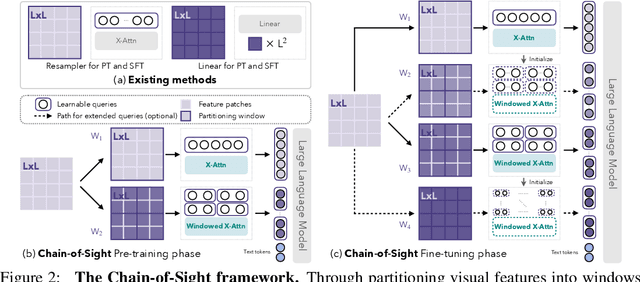

Abstract:This paper introduces Chain-of-Sight, a vision-language bridge module that accelerates the pre-training of Multimodal Large Language Models (MLLMs). Our approach employs a sequence of visual resamplers that capture visual details at various spacial scales. This architecture not only leverages global and local visual contexts effectively, but also facilitates the flexible extension of visual tokens through a compound token scaling strategy, allowing up to a 16x increase in the token count post pre-training. Consequently, Chain-of-Sight requires significantly fewer visual tokens in the pre-training phase compared to the fine-tuning phase. This intentional reduction of visual tokens during pre-training notably accelerates the pre-training process, cutting down the wall-clock training time by ~73%. Empirical results on a series of vision-language benchmarks reveal that the pre-train acceleration through Chain-of-Sight is achieved without sacrificing performance, matching or surpassing the standard pipeline of utilizing all visual tokens throughout the entire training process. Further scaling up the number of visual tokens for pre-training leads to stronger performances, competitive to existing approaches in a series of benchmarks.
SkySense: A Multi-Modal Remote Sensing Foundation Model Towards Universal Interpretation for Earth Observation Imagery
Dec 15, 2023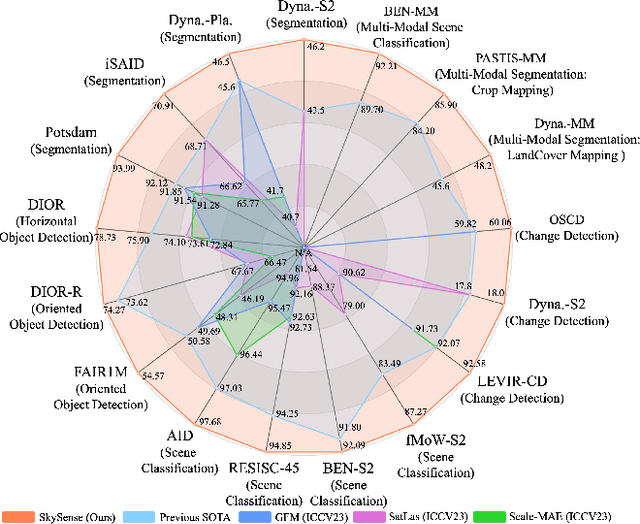
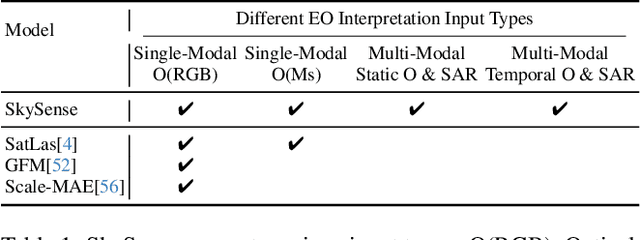
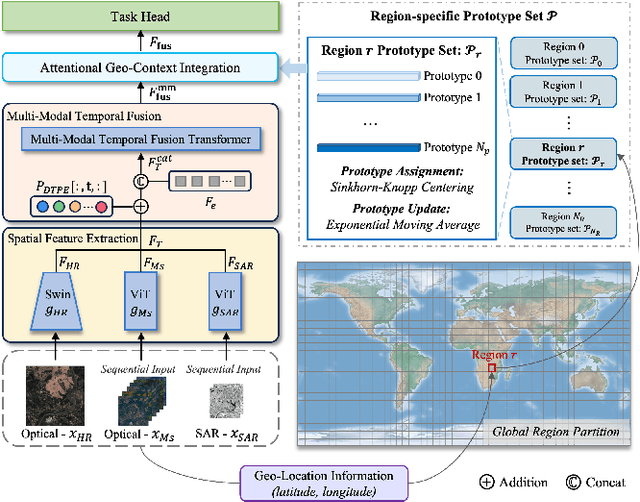
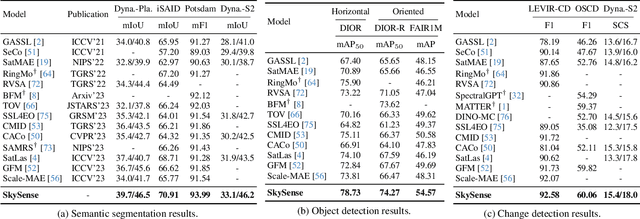
Abstract:Prior studies on Remote Sensing Foundation Model (RSFM) reveal immense potential towards a generic model for Earth Observation. Nevertheless, these works primarily focus on a single modality without temporal and geo-context modeling, hampering their capabilities for diverse tasks. In this study, we present SkySense, a generic billion-scale model, pre-trained on a curated multi-modal Remote Sensing Imagery (RSI) dataset with 21.5 million temporal sequences. SkySense incorporates a factorized multi-modal spatiotemporal encoder taking temporal sequences of optical and Synthetic Aperture Radar (SAR) data as input. This encoder is pre-trained by our proposed Multi-Granularity Contrastive Learning to learn representations across different modal and spatial granularities. To further enhance the RSI representations by the geo-context clue, we introduce Geo-Context Prototype Learning to learn region-aware prototypes upon RSI's multi-modal spatiotemporal features. To our best knowledge, SkySense is the largest Multi-Modal RSFM to date, whose modules can be flexibly combined or used individually to accommodate various tasks. It demonstrates remarkable generalization capabilities on a thorough evaluation encompassing 16 datasets over 7 tasks, from single- to multi-modal, static to temporal, and classification to localization. SkySense surpasses 18 recent RSFMs in all test scenarios. Specifically, it outperforms the latest models such as GFM, SatLas and Scale-MAE by a large margin, i.e., 2.76%, 3.67% and 3.61% on average respectively. We will release the pre-trained weights to facilitate future research and Earth Observation applications.
Res-Tuning: A Flexible and Efficient Tuning Paradigm via Unbinding Tuner from Backbone
Oct 30, 2023Abstract:Parameter-efficient tuning has become a trend in transferring large-scale foundation models to downstream applications. Existing methods typically embed some light-weight tuners into the backbone, where both the design and the learning of the tuners are highly dependent on the base model. This work offers a new tuning paradigm, dubbed Res-Tuning, which intentionally unbinds tuners from the backbone. With both theoretical and empirical evidence, we show that popular tuning approaches have their equivalent counterparts under our unbinding formulation, and hence can be integrated into our framework effortlessly. Thanks to the structural disentanglement, we manage to free the design of tuners from the network architecture, facilitating flexible combination of various tuning strategies. We further propose a memory-efficient variant of Res-Tuning, where the bypass i.e., formed by a sequence of tuners) is effectively detached from the main branch, such that the gradients are back-propagated only to the tuners but not to the backbone. Such a detachment also allows one-time backbone forward for multi-task inference. Extensive experiments on both discriminative and generative tasks demonstrate the superiority of our method over existing alternatives from the perspectives of efficacy and efficiency. Project page: $\href{https://res-tuning.github.io/}{\textit{https://res-tuning.github.io/}}$.
Disentangling Spatial and Temporal Learning for Efficient Image-to-Video Transfer Learning
Sep 14, 2023Abstract:Recently, large-scale pre-trained language-image models like CLIP have shown extraordinary capabilities for understanding spatial contents, but naively transferring such models to video recognition still suffers from unsatisfactory temporal modeling capabilities. Existing methods insert tunable structures into or in parallel with the pre-trained model, which either requires back-propagation through the whole pre-trained model and is thus resource-demanding, or is limited by the temporal reasoning capability of the pre-trained structure. In this work, we present DiST, which disentangles the learning of spatial and temporal aspects of videos. Specifically, DiST uses a dual-encoder structure, where a pre-trained foundation model acts as the spatial encoder, and a lightweight network is introduced as the temporal encoder. An integration branch is inserted between the encoders to fuse spatio-temporal information. The disentangled spatial and temporal learning in DiST is highly efficient because it avoids the back-propagation of massive pre-trained parameters. Meanwhile, we empirically show that disentangled learning with an extra network for integration benefits both spatial and temporal understanding. Extensive experiments on five benchmarks show that DiST delivers better performance than existing state-of-the-art methods by convincing gaps. When pre-training on the large-scale Kinetics-710, we achieve 89.7% on Kinetics-400 with a frozen ViT-L model, which verifies the scalability of DiST. Codes and models can be found in https://github.com/alibaba-mmai-research/DiST.
Towards Real-World Visual Tracking with Temporal Contexts
Aug 20, 2023Abstract:Visual tracking has made significant improvements in the past few decades. Most existing state-of-the-art trackers 1) merely aim for performance in ideal conditions while overlooking the real-world conditions; 2) adopt the tracking-by-detection paradigm, neglecting rich temporal contexts; 3) only integrate the temporal information into the template, where temporal contexts among consecutive frames are far from being fully utilized. To handle those problems, we propose a two-level framework (TCTrack) that can exploit temporal contexts efficiently. Based on it, we propose a stronger version for real-world visual tracking, i.e., TCTrack++. It boils down to two levels: features and similarity maps. Specifically, for feature extraction, we propose an attention-based temporally adaptive convolution to enhance the spatial features using temporal information, which is achieved by dynamically calibrating the convolution weights. For similarity map refinement, we introduce an adaptive temporal transformer to encode the temporal knowledge efficiently and decode it for the accurate refinement of the similarity map. To further improve the performance, we additionally introduce a curriculum learning strategy. Also, we adopt online evaluation to measure performance in real-world conditions. Exhaustive experiments on 8 wellknown benchmarks demonstrate the superiority of TCTrack++. Real-world tests directly verify that TCTrack++ can be readily used in real-world applications.
Temporally-Adaptive Models for Efficient Video Understanding
Aug 10, 2023Abstract:Spatial convolutions are extensively used in numerous deep video models. It fundamentally assumes spatio-temporal invariance, i.e., using shared weights for every location in different frames. This work presents Temporally-Adaptive Convolutions (TAdaConv) for video understanding, which shows that adaptive weight calibration along the temporal dimension is an efficient way to facilitate modeling complex temporal dynamics in videos. Specifically, TAdaConv empowers spatial convolutions with temporal modeling abilities by calibrating the convolution weights for each frame according to its local and global temporal context. Compared to existing operations for temporal modeling, TAdaConv is more efficient as it operates over the convolution kernels instead of the features, whose dimension is an order of magnitude smaller than the spatial resolutions. Further, kernel calibration brings an increased model capacity. Based on this readily plug-in operation TAdaConv as well as its extension, i.e., TAdaConvV2, we construct TAdaBlocks to empower ConvNeXt and Vision Transformer to have strong temporal modeling capabilities. Empirical results show TAdaConvNeXtV2 and TAdaFormer perform competitively against state-of-the-art convolutional and Transformer-based models in various video understanding benchmarks. Our codes and models are released at: https://github.com/alibaba-mmai-research/TAdaConv.
Rethinking Efficient Tuning Methods from a Unified Perspective
Mar 01, 2023Abstract:Parameter-efficient transfer learning (PETL) based on large-scale pre-trained foundation models has achieved great success in various downstream applications. Existing tuning methods, such as prompt, prefix, and adapter, perform task-specific lightweight adjustments to different parts of the original architecture. However, they take effect on only some parts of the pre-trained models, i.e., only the feed-forward layers or the self-attention layers, which leaves the remaining frozen structures unable to adapt to the data distributions of downstream tasks. Further, the existing structures are strongly coupled with the Transformers, hindering parameter-efficient deployment as well as the design flexibility for new approaches. In this paper, we revisit the design paradigm of PETL and derive a unified framework U-Tuning for parameter-efficient transfer learning, which is composed of an operation with frozen parameters and a unified tuner that adapts the operation for downstream applications. The U-Tuning framework can simultaneously encompass existing methods and derive new approaches for parameter-efficient transfer learning, which prove to achieve on-par or better performances on CIFAR-100 and FGVC datasets when compared with existing PETL methods.
Physically Plausible Animation of Human Upper Body from a Single Image
Dec 09, 2022



Abstract:We present a new method for generating controllable, dynamically responsive, and photorealistic human animations. Given an image of a person, our system allows the user to generate Physically plausible Upper Body Animation (PUBA) using interaction in the image space, such as dragging their hand to various locations. We formulate a reinforcement learning problem to train a dynamic model that predicts the person's next 2D state (i.e., keypoints on the image) conditioned on a 3D action (i.e., joint torque), and a policy that outputs optimal actions to control the person to achieve desired goals. The dynamic model leverages the expressiveness of 3D simulation and the visual realism of 2D videos. PUBA generates 2D keypoint sequences that achieve task goals while being responsive to forceful perturbation. The sequences of keypoints are then translated by a pose-to-image generator to produce the final photorealistic video.
 Add to Chrome
Add to Chrome Add to Firefox
Add to Firefox Add to Edge
Add to Edge